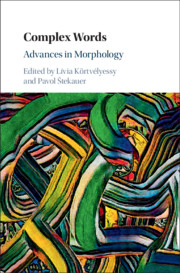Book contents
- Complex Words
- Complex Words
- Copyright page
- Dedication
- Contents
- Contributors
- Introduction: Advances in Morphology
- Part I Lexico-Semantic Aspects of Complex Words
- 1 Formal Semantics and the Problem of Nominalizations
- 2 Semantically Subtractive Morphology
- 3 -less and -free
- 4 Instrument Nouns in -one in Latin and Romance
- 5 Prominence in Noun-to-Verb Conversion
- 6 On Spanish Dvandva and Its Restrictions
- Part II Structure of Complex Words
- Part III Corpus-Based Case Studies
- Index
- References
2 - Semantically Subtractive Morphology
from Part I - Lexico-Semantic Aspects of Complex Words
Published online by Cambridge University Press: 18 September 2020
- Complex Words
- Complex Words
- Copyright page
- Dedication
- Contents
- Contributors
- Introduction: Advances in Morphology
- Part I Lexico-Semantic Aspects of Complex Words
- 1 Formal Semantics and the Problem of Nominalizations
- 2 Semantically Subtractive Morphology
- 3 -less and -free
- 4 Instrument Nouns in -one in Latin and Romance
- 5 Prominence in Noun-to-Verb Conversion
- 6 On Spanish Dvandva and Its Restrictions
- Part II Structure of Complex Words
- Part III Corpus-Based Case Studies
- Index
- References
Summary
Morphologically complex forms are related to their bases in two ways: some alteration (perhaps vacuous) of form is correlated with some alteration (also possibly vacuous) of meaning. In a sort of ideal case, this is representable by the addition of a morpheme bearing both phonological and semantic content, comparable to a Saussurean (minimal) sign. Criticism of the claim that this is indeed the general case has focused on formal relations that cannot be seen as strictly additive: ablaut, umlaut, consonant shifts, metathesis, truncation, and other markers that apparently change the shape of the base rather than simply adding material to it. The present paper brings into the discussion the opposite side of this coin: instances in which it is the semantics, rather than the phonology of the base form, that is altered in a non-additive way in a morphologically derived form. Specific cases involve the removal of a component of meaning associated with one argument of the base, correlated with the addition of a component of form. These examples constitute a challenge for morpheme-based views of morphology, comparable to that posed by non-concatenative formal markers, and a challenge to the claim that morphology is always semantically monotonic.
- Type
- Chapter
- Information
- Complex WordsAdvances in Morphology, pp. 36 - 54Publisher: Cambridge University PressPrint publication year: 2020

